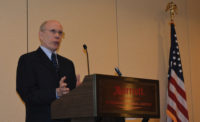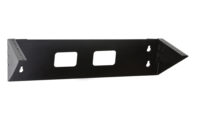Furniture and console systems have evolved to accommodate new technologies. Simpler, streamlined consoles are now possible because there are fewer appliances and more components are now hidden away (using racks) in an equipment room.
Effectively designing a console system requires investing time upfront to analyze and understand the customer’s needs, says Wayne Cook, vice president of sales for Winsted. What equipment is going on the console? How big? What is its functionality? Cook says furniture systems should be designed to address day-to-day operational tasks and also with the flexibility to accommodate extra operators in a crisis situation. In an emergency response situation, an additional large-screen monitor can be used to display important images and collaborative work stations can provide connections for PCs and extra telephones.
Cook also says furniture should be designed with a view toward the future. Technology may change in three to five years, but consoles typically stay in place for 15 to 18 years, and most people don’t think that far ahead.
Control room furniture modules no longer only come in 24-inch blocks. Flexible designs are now tailored to the customer’s needs, Cook says. Suppliers can help integrators by creating customized designs based on site visits or video, using CAD drawings and providing full-color renderings of the room to share with end user clients.
Human factors are also important to consider when designing consoles, Cook comments. The ISO standard 11064, being adopted throughout the world, addresses the ergonomics of console design. For example, the primary monitor should be located 40 degrees below the horizon to allow an operator to sit in a relaxed position and avoid neck and eye strain. When an operator looks down slightly, his or her eyelids are not as wide open, which can help avoid dry eyes over long periods.
Console designs now incorporate cable management of both data and power lines. Modular designs are easier to assemble on-site. Winsted offers the Versa Trak monitor array system, an aluminum extrusion rail across the back of consoles to allow unlimited adjustment and reconfiguration of monitors.
Monitor sizes are growing rapidly — at lower costs — and furniture systems have to adjust. Smaller monitors for desktop applications are becoming cost-prohibitive because the consumer market’s economies of scale favor larger sizes. Multiple camera views displayed on a single large monitor are replacing yesterday’s many single monitors, another trend that impacts how consoles are designed.
In general, eye-catching designs are replacing yesterday’s choice of “any color as long as it’s black.” New choices of work surfaces, side panels and Corian and new translucent materials are favored. Management often wants to show off the security room as a key asset. Winsted’s Envision series is a streamlined console system that takes advantage of less need for appliance storage.
Cook says touchscreen technology is also impacting console design. Physical keyboards are being replaced by on-screen keyboards and even virtual keyboards projected onto a console’s work surface.
Not Just Racks but Integrated Systems
The security industry’s transition to IP systems increases the need for integrated rack systems that include advanced functionality such as cable management, thermostat-controlled cooling systems and power systems monitored on the IP network, says Mark Tracy, director of product and business development for Middle Atlantic Products. Cooling is critical with the transition to hard disk drives and servers subject to overheating, and reliability depends on well-functioning support systems. An integrator can help ensure reliability by installing a sensor device that can alert the facility manager or start an auxiliary fan if the temperature rises above a set threshold or a fan fails. Today’s racks are not just hardware, but integrated enclosure systems that provide the needed infrastructure for newer IP technologies.
Tracy also suggests planning ahead when designing rack systems to anticipate future changes in technology. It may be impossible to future-proof a rack system, but rack manufacturers such as Middle Atlantic Products are designing in functionality to prepare for technology changes over time, such as a transition from copper cabling to fiber-optic cabling. Middle Atlantic offers the tool-free LeverLock internal management system including cable management bars and vertical accessory mounting plates. The systems allow integrators to install small components such as DC power supplies and encoders vertically on the side of the rack, which saves space and makes them easy to remove for servicing.
Deeper components are driving a trend toward deeper racks – 36-, 42- or even 48-inch as required by newer NVR-based systems. Deeper racks also make it easier to manage cabling and vertical power strips, while encouraging airflow.
When retrofitting analog systems, installers should retrofit the support and infrastructure systems as well as change the core technologies. In addition to greater functionality, new racks are available with curved doors and in various colors, including anti-microbial white for use in healthcare environments.
Neat, workmanlike wiring can encourage user confidence while making it easy to service the system and upgrade it later. A variety of horizontal and vertical cable managers help promote neatness and relieve strain to connectors. As cabling becomes denser, effective cable management contributes to improved air flow to help keep systems cool, too.
Regarding furniture, Middle Atlantic simplifies on-site assembly and minimizes field time by offering console bays that are unitized, one-piece construction, factory pre-assembled with as few components as possible.
Megapixel cameras and high-resolution displays are driving the need for furniture with enhanced ergonomics, says Tracy. Middle Atlantic designs consoles to meet operator needs, including providing an ergonomic line-of-sight tool in their Designer software. Their new sit/stand console provides an adjustable-height work surface to accommodate users in both sitting and standing positions.
Consider Costs and ROI
Keith Fulmer, president of Video Mount Products, says some integrators are still not using racks in their day-to-day installations. It’s a missed opportunity to provide a professional installation that is neat and orderly, and worth the added costs.
When arranging equipment in racks, Fulmer says it’s critical to remember the dynamics of gravity. Heavy items, such as power supplies, should go to the bottom to ensure rack stability. He says a supplier’s weight capacity assumes an even distribution of weight from top to bottom.
Racks can provide a return on investment for integrators by making it easier to service and update systems — no more spending hours tracing wire because everything is easily accessible. Positioning systems most likely to need service or upgrades waist-high can help avoid reaching or kneeling in a service call. Integrators should consider the costs of not using racks, in terms of the added costs of providing service, and not just the price of the racks, said Fulmer.
A variety of rack sizes can serve any application need. VMP offers a four-foot rack, suitable for a residential home theater installation. The company also offers a rack-mountable lock box that can keep NVRs under lock and key. VMP’s four-post expansion kit accommodates deeper shelves for heavier components, and cable management accessories keep installations neat.
Fulmer also recommends installing a 10- to 17-in monitor in a rack to avoid the need to use a test monitor during service. VMP offers an LCD monitor rack mount that can position smaller monitors recessed into the rack or be inverted to be used with larger monitors.
Furniture More than a Commodity
Consoles promote an effective human-to-machine interface, says Christopher J. Devaney, marketing communications manager, Eaton. The supplier’s Profile Command and Control Console is a height-adjustable, ergonomic console for mission-critical applications such as security. Devaney says consoles and racks that are modular and scalable can meet current equipment requirements and be easily scaled later to meet future demands.
Devaney says furniture today isn’t a commodity item, but presents an opportunity to optimize system productivity and efficiency. Eaton features include high-capacity cable raceways with multiple entry and exit points to manage floor-fed cabling and lateral and vertical routing of cables. Durability is also an emphasis.
Console design, in conjunction with the layout of the room, should provide employees an unobstructed line of sight to view large video display walls, says Devany. Eaton’s Paramount enclosure and Profile console are designed with clean, sleek lines that complement state-of-the-art environments.





